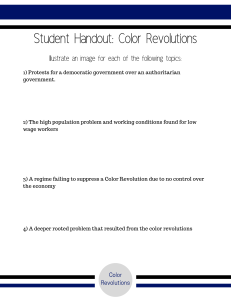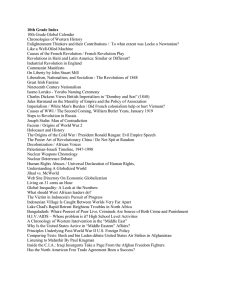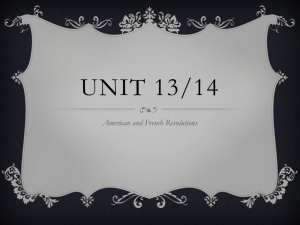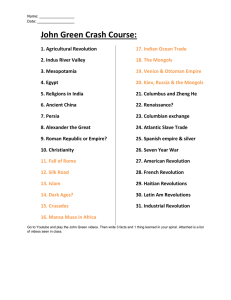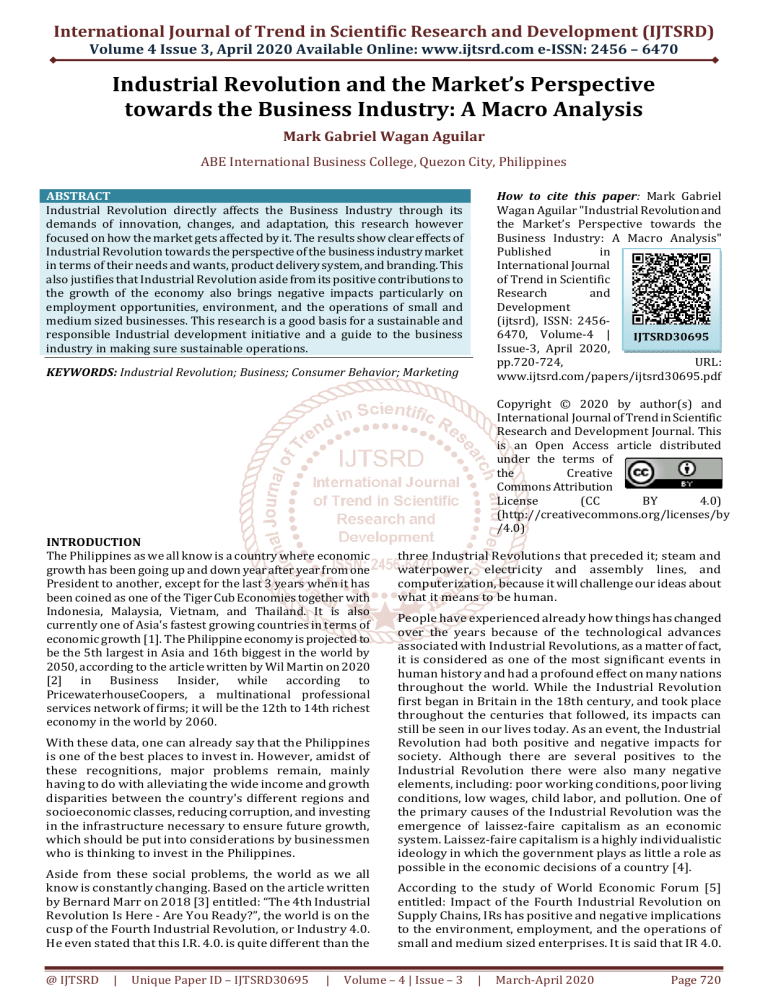
International Journal of Trend in Scientific Research and Development (IJTSRD)
Volume 4 Issue 3, April 2020 Available Online: www.ijtsrd.com e-ISSN: 2456 – 6470
Industrial Revolution and the Market’s Perspective
towards the Business Industry: A Macro Analysis
Mark Gabriel Wagan Aguilar
ABE International Business College, Quezon City, Philippines
How to cite this paper: Mark Gabriel
Wagan Aguilar "Industrial Revolution and
the Market’s Perspective towards the
Business Industry: A Macro Analysis"
Published
in
International Journal
of Trend in Scientific
Research
and
Development
(ijtsrd), ISSN: 24566470, Volume-4 |
IJTSRD30695
Issue-3, April 2020,
pp.720-724,
URL:
www.ijtsrd.com/papers/ijtsrd30695.pdf
ABSTRACT
Industrial Revolution directly affects the Business Industry through its
demands of innovation, changes, and adaptation, this research however
focused on how the market gets affected by it. The results show clear effects of
Industrial Revolution towards the perspective of the business industry market
in terms of their needs and wants, product delivery system, and branding. This
also justifies that Industrial Revolution aside from its positive contributions to
the growth of the economy also brings negative impacts particularly on
employment opportunities, environment, and the operations of small and
medium sized businesses. This research is a good basis for a sustainable and
responsible Industrial development initiative and a guide to the business
industry in making sure sustainable operations.
KEYWORDS: Industrial Revolution; Business; Consumer Behavior; Marketing
Copyright © 2020 by author(s) and
International Journal of Trend in Scientific
Research and Development Journal. This
is an Open Access article distributed
under the terms of
the
Creative
Commons Attribution
License
(CC
BY
4.0)
(http://creativecommons.org/licenses/by
/4.0)
INTRODUCTION
The Philippines as we all know is a country where economic
growth has been going up and down year after year from one
President to another, except for the last 3 years when it has
been coined as one of the Tiger Cub Economies together with
Indonesia, Malaysia, Vietnam, and Thailand. It is also
currently one of Asia's fastest growing countries in terms of
economic growth [1]. The Philippine economy is projected to
be the 5th largest in Asia and 16th biggest in the world by
2050, according to the article written by Wil Martin on 2020
[2] in Business Insider, while according to
PricewaterhouseCoopers, a multinational professional
services network of firms; it will be the 12th to 14th richest
economy in the world by 2060.
With these data, one can already say that the Philippines
is one of the best places to invest in. However, amidst of
these recognitions, major problems remain, mainly
having to do with alleviating the wide income and growth
disparities between the country's different regions and
socioeconomic classes, reducing corruption, and investing
in the infrastructure necessary to ensure future growth,
which should be put into considerations by businessmen
who is thinking to invest in the Philippines.
Aside from these social problems, the world as we all
know is constantly changing. Based on the article written
by Bernard Marr on 2018 [3] entitled: “The 4th Industrial
Revolution Is Here - Are You Ready?”, the world is on the
cusp of the Fourth Industrial Revolution, or Industry 4.0.
He even stated that this I.R. 4.0. is quite different than the
@ IJTSRD
|
Unique Paper ID – IJTSRD30695
|
three Industrial Revolutions that preceded it; steam and
waterpower, electricity and assembly lines, and
computerization, because it will challenge our ideas about
what it means to be human.
People have experienced already how things has changed
over the years because of the technological advances
associated with Industrial Revolutions, as a matter of fact,
it is considered as one of the most significant events in
human history and had a profound effect on many nations
throughout the world. While the Industrial Revolution
first began in Britain in the 18th century, and took place
throughout the centuries that followed, its impacts can
still be seen in our lives today. As an event, the Industrial
Revolution had both positive and negative impacts for
society. Although there are several positives to the
Industrial Revolution there were also many negative
elements, including: poor working conditions, poor living
conditions, low wages, child labor, and pollution. One of
the primary causes of the Industrial Revolution was the
emergence of laissez-faire capitalism as an economic
system. Laissez-faire capitalism is a highly individualistic
ideology in which the government plays as little a role as
possible in the economic decisions of a country [4].
According to the study of World Economic Forum [5]
entitled: Impact of the Fourth Industrial Revolution on
Supply Chains, IRs has positive and negative implications
to the environment, employment, and the operations of
small and medium sized enterprises. It is said that IR 4.0.
Volume – 4 | Issue – 3
|
March-April 2020
Page 720
International Journal of Trend in Scientific Research and Development (IJTSRD) @ www.ijtsrd.com eISSN: 2456-6470
will introduce efficient ways to use materials, production
mechanisms, and transportation means. Technological
advances brought by it will also transform the world of
work which will be a challenge to humans due to skills
shortage, automation changes in regulations and legal
framework conditions, thus, personnel development is
highly needed. Small and medium sized enterprises on the
other hand is said to get support from the large
corporations since such will focus on research and
development while SMEs will focus on job creation. SMEs
would also benefit from IR 4.0. if the government will help
them in acquiring technological advancements.
Industrial Revolutions also has direct impacts towards
marketing in particular; Products has become accessible
to the market online with the help of the internet, and
businesses started to use barcodes and QR codes so that
consumers can access product information by just
scanning; Prices of products has also become lower since
selling on the web reduces the use of resources than in
the physical environment; Place as part of the marketing
mix is also affected since Industrial Revolutions with the
innovations it has brought allowed business to work with
less intermediaries and employees [6]; and Promotion
has become faster particularly marketing activities which
has changed from traditional media that uses a push type
strategy to internet and mobile technologies that use pull
type strategies, [7].
Table 1 shows that the market believes that Industrial
Revolution brings changes more than anything with a
score of 22%, while some thinks of Machines (21%),
Innovation (17%), Threat (12%), Technology (9%), and
other terms such as Manufacturing, Economy, Marketing,
Business, and Buildings among other in defining
Industrial Revolution with a score of (20%).
Figure 1: On what degree do Industrial Revolutions
affect the market’s perspective towards general
needs and wants?
Figure 1 shows that the market’s perspective towards
their needs and wants is extremely affected by Industrial
Revolutions with score of 49% among 385 respondents.
44% of them said that it only affects them a little, while
7% believe that it don’t affect their needs and wants.
Now that the 4th Industrial Revolution is coming, amidst
studies associated with it, the business industry should
still be ready; no one knows what changes and up to what
extent in reality this transition would bring to the world.
METHODS
This study was done through data gathering from
published research papers, books, online articles,
newspapers, and an online survey participated by 385
respondents from Quezon City, the Philippines largest city
in terms of population, which were selected randomly.
The sample size was computed through raosoft sample
size calculator with 5% margin of error, 95% confidence
level, and 50% response distribution. The data gathering
lasted for 3 weeks from the 10th day of February and
ended on the 1st day of the following month; year 2020.
The survey was consisted a total of 20 questions that had
100% response rate from respondents.
RESULTS
The results of this study were calculated through a
quantitative research approach focusing on frequency
and percentage method. Thematic Analysis was used in
Table 1 aside from the frequency and percentage method.
Table 1: Terms chosen by the market to formally
define Industrial Revolutions
Responses
Frequency
Percentage
Innovation
65
17%
Changes
83
22%
Technology
34
9%
Threat
46
12%
Machines
80
21%
Others (Manufacturing,
Economy, Useful,
78
20%
Marketing, Business,
Buildings, etc)
@ IJTSRD
|
Unique Paper ID – IJTSRD30695
|
Figure 2: How do Industrial Revolutions affect the
market’s perspective towards their needs and
wants?
Figure 2 shows that the market’s needs and wants change
based on the trend and what is efficient and useful in the
current time but with consideration on branding and the
reputation of the company with a score of 58% out of the
total number respondents. 40% of the respondents
however said that their needs and wants change because
on the same but without considering the brand and the
company’s reputation, while the needs and wants of the
remaining 2% were not affected by Industrial
Revolutions.
Figure 3: On what degree do Industrial Revolutions
affect the market’s perspective towards product
delivery?
Figure 3 shows that the market’s perspective towards
product delivery is extremely affected with a score of
Volume – 4 | Issue – 3
|
March-April 2020
Page 721
International Journal of Trend in Scientific Research and Development (IJTSRD) @ www.ijtsrd.com eISSN: 2456-6470
45% out of the total number of respondents. 44%
however said that their preference towards product
delivery is affected only a little, while the preference of
the 11% of the market is not affected.
forgotten old school branding approach. 22% of the
market said that their preference does not change easily,
and that they prefer authentic image of the company but
occasionally gets attracted through modern branding
techniques, while 14% of the market has a preference
similar to the 22% but totally does not consider modern
branding techniques. The remaining 1% said that their
preference towards branding is not affected by Industrial
Revolutions.
Figure 4: How do Industrial Revolutions affect the
market’s perspective towards product delivery?
Figure 4 shows that the market’s perspective towards
product delivery changes based on trends and efficiency,
however, the market occasionally prefers traditional ways
with a score of 26% on both. 25% of the market on the
other hand said that their preference towards product
delivery does not change easily amidst Industrial
Revolutions, and that they prefer traditional ways more
than modern ways, 21% said the other way around, while
the preference of the remaining 2% totally is not affected
by IRs.
Figure 5: On what degree do Industrial Revolutions
affect the market’s perspective towards branding?
Figure 5 shows that the market’s perspective towards
branding is extremely affected by Industrial Revolutions
with a sore of 48% out of the 385 respondents. 45% said
that their perspective is affected a little only, while 8%
said that their perception stayed the same despite of
Industrial Revolutions.
Figure 6: How do Industrial Revolutions affect the
market’s perspective towards branding?
Figure 6 shows that with a score of 32% the market’s
perspective towards branding changes based on trend,
attractiveness, and creativity based on the Industrial
changes, but occasionally into old school branding. 30%
of the market on the other hand experiences changes on
their preference based on the same, but has totally
@ IJTSRD
|
Unique Paper ID – IJTSRD30695
|
Figure 7: Does the market see Industrial
Revolutions a threat to them in terms of
employment opportunities?
Figure 7 shows that the market sees Industrial
Revolutions as threat to them in terms of employment
opportunities with a score of 88% out of the 385
respondents, while 12% said that it isn’t.
Figure 8: The market’s perspective towards how do
Industrial Revolutions threaten humans in terms of
employment opportunities.
Figure 8 shows that with a score of 85%, Industrial
revolutions is a threat to humans in terms of employment
opportunities because it create modern- technologically
aligned environments that reduce business firms need of
manpower, while 15% said that IRs is not a threat to
them.
Figure 9: Does the market see Industrial
Revolutions a threat to environmental conservation
efforts?
Figure 9 shows that Industrial Revolutions is a threat to
environmental conservation efforts in the eyes of the
industry’s market with a score of 83%, while the
remaining said that it is not a threat to such.
Volume – 4 | Issue – 3
|
March-April 2020
Page 722
International Journal of Trend in Scientific Research and Development (IJTSRD) @ www.ijtsrd.com eISSN: 2456-6470
Figure 10: The market’s perspective towards how
do Industrial Revolutions threaten environmental
conservation efforts.
Figure 13: Awareness of the market towards
Industrial Revolutions prior to answering the
survey.
Figure 10 shows that with a score of 86%, the market
believes that Industrial Revolutions threatens
environmental conservation efforts because it creates
modern- technologically aligned environments that
negatively affect nature through excessive resource
consumption and pollution, while 14% of the market
believes that IRs don’t.
Figure 13 shows that majority or 81% of the total
respondents of this study is aware of the term Industrial
Revolution prior to answering the survey, while 19% was
not.
Figure 11: Does the market see Industrial
Revolutions a threat to small and medium
enterprises / business firms?
Figure 11 shows that the Industry’s market believes that
Industrial Revolutions is a threat to small and medium
enterprises / business firms with a score of 88% out of
the total number of respondents, while 12% believes that
it is not a threat to such.
Figure 12: The market’s perspective on how do
Industrial Revolutions threaten small and medium
enterprises/ business firms.
Figure 12 shows that the market believes IRs is a threat to
small and medium enterprises because it create moderntechnologically aligned environments that makes
competition difficult to businesses that does not have the
enough resources with a score of 82%, while the
remaining 18% believes that it is not.
@ IJTSRD
|
Unique Paper ID – IJTSRD30695
|
DISCUSSION AND FINDINGS
It was found out that the Business Industry Market is fully
aware of what Industrial Revolution is, making this study
reliable; it is clearly reflected on the result in Table 1 and
Figure 13 where the market believes that Industrial
Revolution brings changes, has introduced machines, a
threat to the environment, industry’s human resource,
and smaller type of businesses, and the reason for
technological advances.
The introduction of technology and/or ways to develop
and present a product has indeed affected the perspective
of the market towards their needs and wants, how the
product is served to them, and the credibility and
reliability of the product manufacturer and promotional
technique used. Amidst the transition from one Industrial
Revolution to another, the needs and wants of the market
changes based on the trends and what is useful in the
current time but with consideration of the reputation of
the manufacturer and/or marketing company, while
when it comes to how the products is served, the market’s
perspective changes based on the trend which for
example during IR 3.0, is online and through electronical
means such as a key card instead of steel key to open a
hotel room door, and the efficiency but still occasionally
prefers traditional ways such as over the counter
payment and written mail. While in terms of branding, the
market gets attracted to a brand based on its ability of
catch up to the trend with a unique and creative approach
in marketing, but in some cases, still gets hooked to old
school branding or the classic way to do things.
Results in figures 7, 9, and 11 clearly explains why 12% of
the market used the term “Threat” to define Industrial
Revolution; despite its contributions to the Industry, IRs
bring problems toward employment opportunities,
environmental conservation efforts, and the operations of
small and medium sized businesses. The Industrial
Revolution 4.0 for example is believed to introduce
Artificial Intelligence or in layman’s term is Robots, which
will take the place of humans in doing procedural jobs.
Machines in addition used by factories to make product
production faster release chemicals that damage the
environment, and that the establishment of corporations
that have the resources to support the changes happening
in the Industry will little by little force the closure of the
Volume – 4 | Issue – 3
|
March-April 2020
Page 723
International Journal of Trend in Scientific Research and Development (IJTSRD) @ www.ijtsrd.com eISSN: 2456-6470
smaller ones which cannot afford to quickly cope up with
the innovation demanded by the economy.
CONCLUSION
Industrial Revolution though it has brought a lot of good
things to the economy, is undoubtedly also a contributor
to the problems people are facing today; pollution,
unemployment, and monopoly and oligopoly among
others. It also has an extreme effect towards the business
industry particularly towards the perspective of the
market; the needs and wants of customers amidst
Industrial Revolutions changes based on trend and if the
products are necessary in the current time based on its
usefulness, however, businesses should still work on the
branding of each product for it is still considered; the
traditional way of providing services and presenting
products is still preferred amidst innovative approaches
done by businesses but the market focuses more on what
is more efficient in the current time, thus, businesses
should adopt innovative methods towards product
delivery but with a touch of traditional ways; and
branding similar to what the market prefers in terms of
product delivery should focus more on the trend with
emphasis on the attractiveness and a unique approach to
the market, but still with consideration of the way the
company has introduced itself before, thus, not
completely leaving its authentic image behind. This
research hereby concludes that businesses should not
innovate or change completely amidst transition from one
Industrial Revolution to another.
@ IJTSRD
|
Unique Paper ID – IJTSRD30695
|
The researcher highly recommends the execution of a
research that micro-analyzes the results of this study;
identify market segments, determine reasons or
motivational factors that affect the perspective of the
market, and suggest systematic practices that will
minimize the negative effects of Industrial Revolution.
REFERENCES
[1] Davies, 2002: Asian Marketing, Market Research, and
Economic Capsule Review/ Asia Market Research
[2] Martin, 2017: 32 most powerful economies in the
world by 2050/ Business Insider UK
[3] Marr, 2018: The 4th Industrial Revolution is here-Are
you ready?/ Forbes Media LLC
[4] History Crunch Writers, 2019: Impacts of the Industrial
Revolution/ History Crunch
[5] Lehmacher et al, 2017: Impact of the Fourth Industrial
Revolution on Supply Chains/ World Economic Forum,
Ref. 061117-00035015
[6] Alim, 2019: The Impact of Industrial Revolution to
Marketing/ Electronic Journal of Social Sciences and
Humanities, ISSN: 2706-8242
[7] Li & Du, 2012: Building a targeted mobile advertising
system for location-based services/ Decision Support
Systems Journal, ISSN: 0167-9236
Volume – 4 | Issue – 3
|
March-April 2020
Page 724



